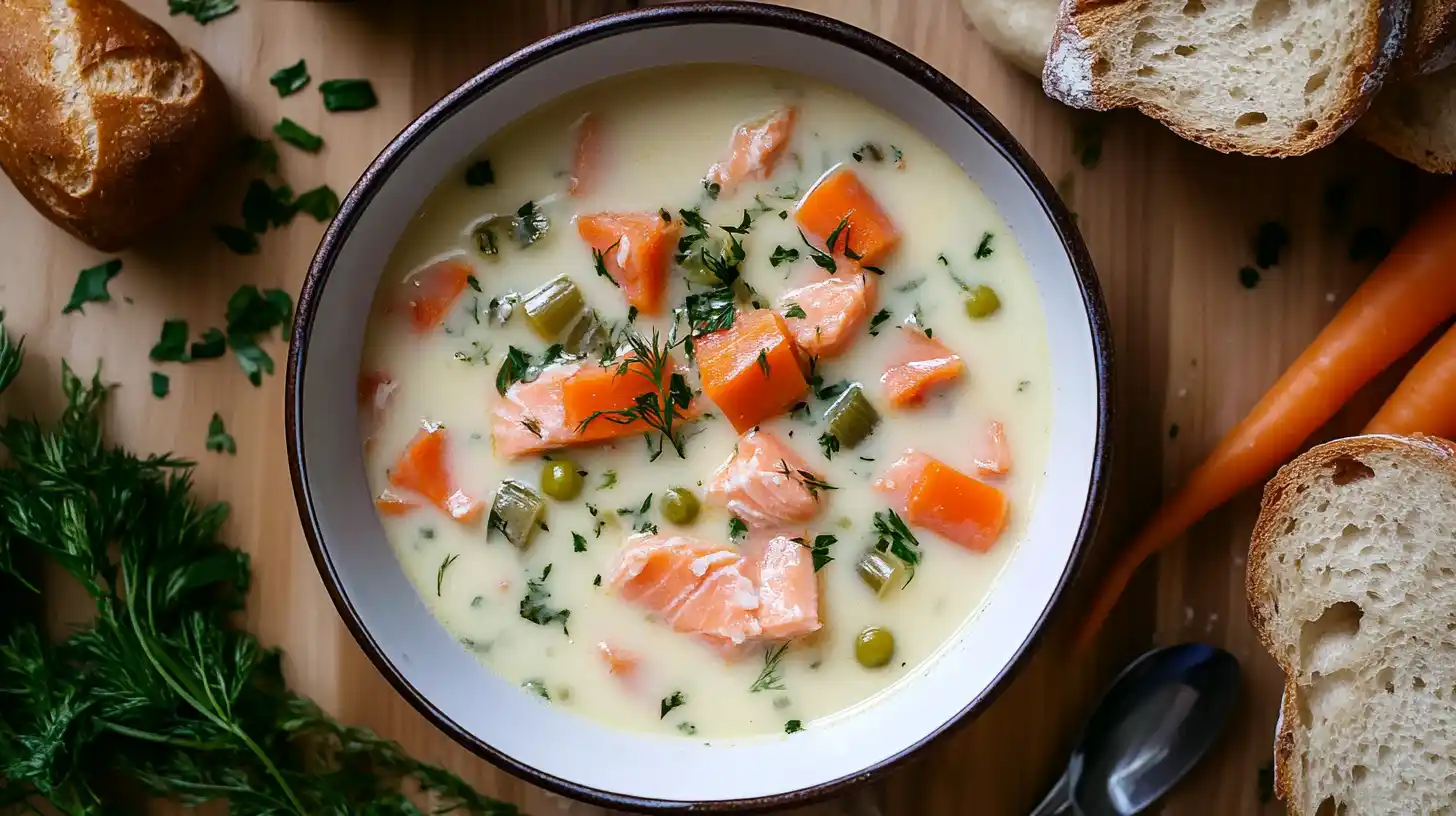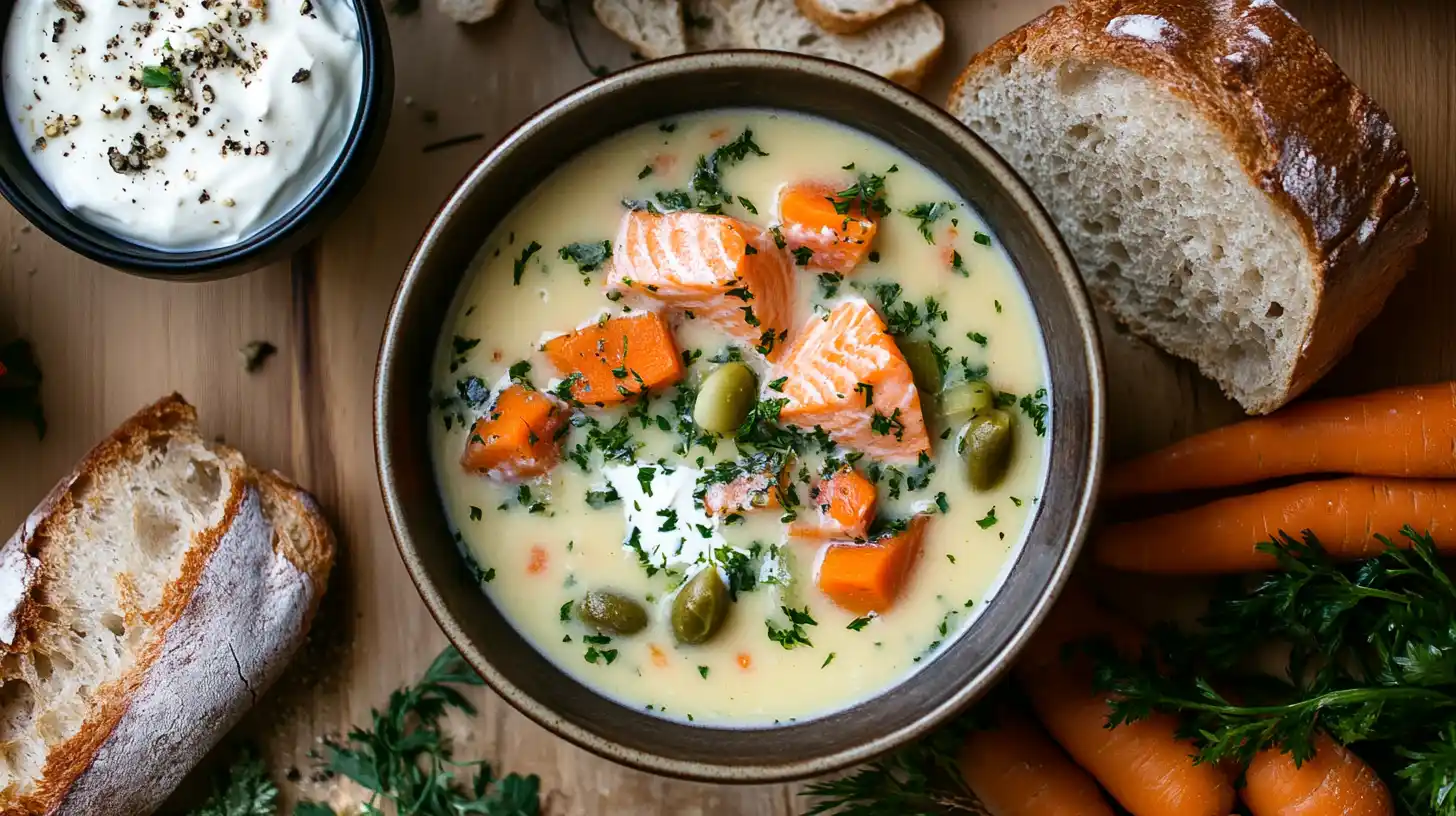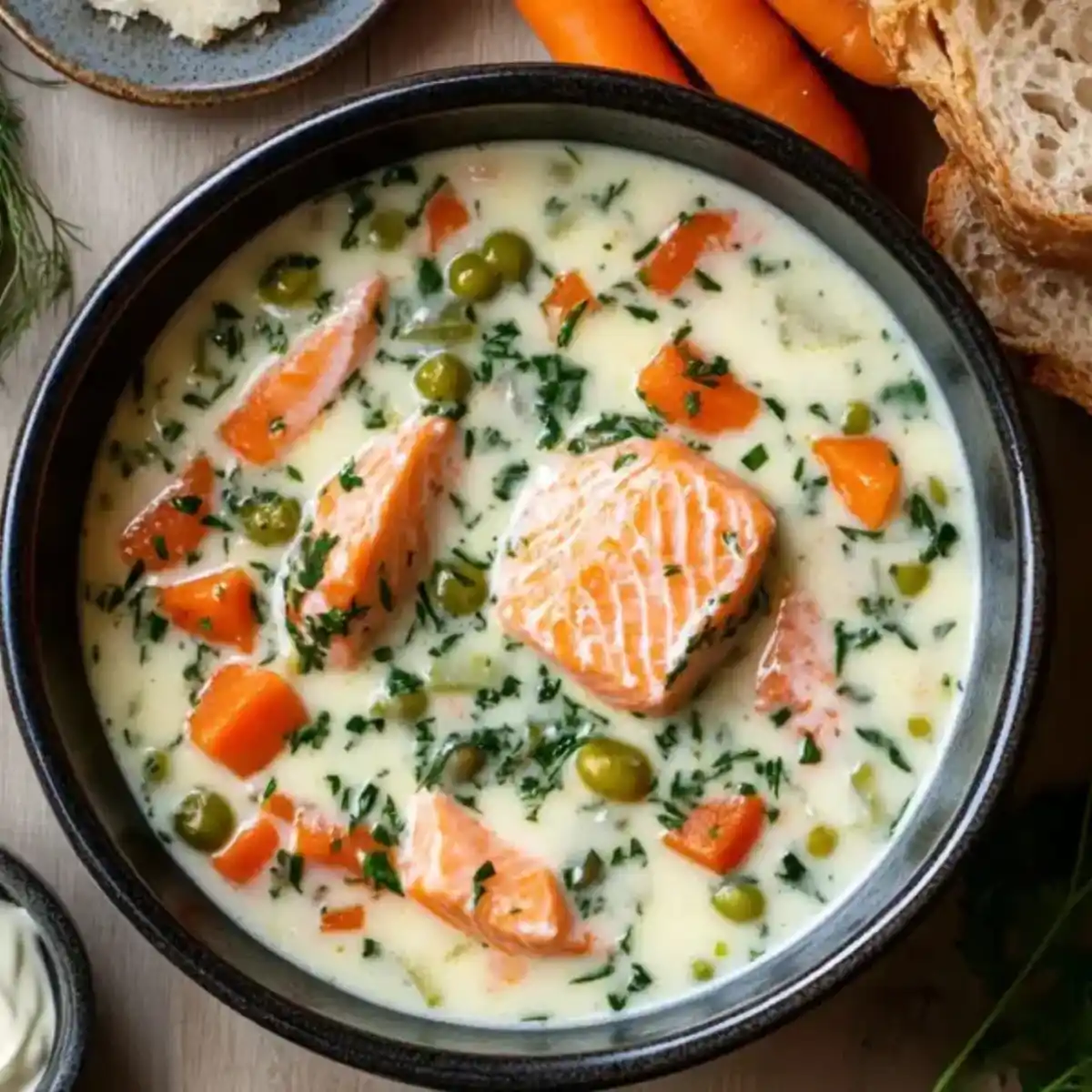Every time I use my grandmother’s Dutch oven, I remember her velvety potato soup. Making that silky texture is more than cooking—it’s an art. It turns simple ingredients into a warm, comforting meal. The secret to creamy soup lies in understanding texture and consistency.

Table of Contents
When you want a soup that feels luxurious on your spoon, knowing the right techniques is key. Getting that creamy texture isn’t just about adding ingredients randomly. It takes precision, skill, and knowing how ingredients work together.
Learning to make creamy soup is a skill anyone can master. It starts with the right thickening agents and blending techniques. Your journey to making perfect soup begins here, with tips to make your kitchen a place of texture magic.
Key Takeaways
- Creamy soup texture relies on specific cooking techniques
- Understanding ingredient interactions is crucial for consistency
- Multiple methods exist for achieving a velvety soup texture
- Thickening agents play a significant role in soup creaminess
- Proper blending techniques enhance overall soup smoothness
The Science Behind Creamy Soup Texture
Creating the perfect creamy soup is more than just cooking. It’s about the science of texture and how ingredients interact. This magic turns simple ingredients into a luxurious dish.

Understanding Viscosity and Mouthfeel
Viscosity is key to a great soup. It affects how thick and smooth the soup feels. The right consistency can elevate a dish from ordinary to unforgettable.
- Viscosity measures a liquid’s resistance to flow
- Higher viscosity creates a more luxurious mouthfeel
- Proper ingredient selection impacts soup thickness
Explore Related Recipes and Tips
- Easy Creamy Salmon Soup Recipe Ready in 30 Minutes
Learn how to create a silky salmon soup in under half an hour, combining ease and rich flavors. - Light Cream: Your Guide to This Versatile Dairy Product
Discover the role of light cream in soups and how it balances richness with health-conscious choices. - Creative Marry Me Chicken Tortellini Recipe
A creamy pasta dish that highlights thickening and blending techniques for a perfect texture. - Homemade Chicken and Dressing Recipe
Dive into the art of making hearty, creamy dishes that double as comforting classics. - Creamy Escarole and Bean Soup Recipe That Satisfies
A perfect example of how to use blended beans to achieve a naturally creamy texture without heavy dairy.
The Role of Fat Molecules in Creaminess
Fat molecules are crucial for creamy soups. They mix with other ingredients through emulsification. This creates a smooth, velvety texture that feels luxurious in your mouth.
“Fat is flavor, and in soups, it’s also texture.” – Professional Chef
Emulsification happens when fat droplets mix evenly with liquid. This makes the soup rich and consistent. Different fats can make the soup creamier in different ways.
Temperature Effects on Texture
Temperature greatly affects a soup’s texture. Changing the temperature can alter the soup’s consistency and feel.
| Temperature Range | Texture Impact |
|---|---|
| Cold (below 40°F) | Thickens and solidifies |
| Warm (100-160°F) | Optimal creamy consistency |
| Hot (above 180°F) | Potential separation of ingredients |
Knowing these scientific facts can help you make soups with the perfect texture every time.
Essential Thickening Agents for Velvety Soups
To make the perfect creamy soup, you need to know about thickening agents. Flour and cornstarch are key. They turn a thin broth into a smooth, luxurious soup.

Each thickening agent has its own way of improving soup texture. Flour is a classic choice for thickening. Cornstarch, on the other hand, makes soups silky and smooth.
- Flour: Traditional wheat-based thickener
- Cornstarch: Gluten-free alternative
- Potato starch: Quick-acting thickening agent
- Arrowroot: Ideal for clear soups
“The secret to a perfect soup lies in mastering your thickening technique” – Professional Chef
Using thickening agents right is key. For flour, make a roux by cooking it with fat before adding liquid. Cornstarch needs cold water to avoid clumps.
| Thickening Agent | Ideal Soup Type | Thickening Power |
|---|---|---|
| All-Purpose Flour | Hearty, creamy soups | Moderate |
| Cornstarch | Light, clear soups | High |
| Potato Starch | Gluten-free recipes | Very High |
Each thickening agent is special. Try different ones to get the perfect soup texture. Start with a little and add more until it’s just right.
What Makes Soup Creamy?
Making the perfect creamy soup is an art. It mixes science with cooking skills. Knowing how to make soup creamy is key for both home cooks and chefs.
Physical Properties of Creamy Soups
Creamy soups have certain physical traits. They are smooth, thick, and feel good in your mouth. Adding pureed veggies or cream changes the soup’s basic structure.
- Viscosity determines the soup’s thickness
- Smooth texture prevents separation
- Even distribution of ingredients ensures consistent creaminess
Chemical Reactions During Cooking
Cooking changes soup in amazing ways. Starches break down, making the soup thicker. Proteins also change, helping everything stick together for a smooth feel.
“The magic of creamy soup happens at the molecular level” – Professional Chef Marcus Rodriguez
Impact of Ingredients Selection
What you choose to put in your soup matters a lot. Cream adds richness, while pureed veggies make it lighter. Each ingredient adds its own special touch to the soup’s creaminess.
| Ingredient Type | Creaminess Level | Texture Characteristics |
|---|---|---|
| Heavy Cream | High | Rich, dense, smooth |
| Pureed Potatoes | Medium | Starchy, thick, slightly grainy |
| Blended Cashews | Medium-Low | Nutty, light, silky |
Learning these tips lets you make soups that are creamy and delicious. It shows off your cooking talent.
Mastering the Art of Roux Making
Making a perfect roux is key for any home cook wanting to improve their soup-making. A roux is a mix of butter and flour that thickens soups and sauces well.
Learning about roux can really boost your cooking skills. It’s about mixing equal parts of butter and flour over low heat. This creates a smooth base that enriches your dishes.
- White roux: Cooked for 2-3 minutes, ideal for light sauces
- Blond roux: Cooked 5-6 minutes, develops a slightly nutty flavor
- Brown roux: Cooked 10-15 minutes, provides deep, robust taste
“A perfect roux is the secret weapon of professional chefs” – Culinary Institute of America
Getting good at roux takes practice and focus. Begin by melting butter in a heavy pan. Then, slowly add flour while whisking until it’s smooth. Cook it slowly, stirring often to avoid burning.
| Roux Type | Cooking Time | Flavor Profile | Best Used For |
|---|---|---|---|
| White Roux | 2-3 minutes | Mild | Cream soups, light sauces |
| Blond Roux | 5-6 minutes | Nutty | Velouté sauces, lighter stews |
| Brown Roux | 10-15 minutes | Rich, intense | Gumbo, dark sauces |
The secret to a great roux is finding the right balance of butter and flour. Use equal weights, like 4 ounces of each. Remember, cooking slowly is key to getting flavor without burning.
Using Dairy Products for Rich, Creamy Texture
Dairy products are your secret weapon for making ordinary soups into luxurious, velvety delights. The right dairy ingredients can make your soup smooth and creamy. This makes every spoonful a culinary experience.
When making rich cream-based soups, knowing the unique properties of different dairy products is key. Each type adds its own magic to your cooking.
Heavy Cream vs. Half-and-Half: Choosing Your Creamy Base
Your choice of dairy greatly affects the soup’s texture. Here’s a quick comparison:
- Heavy Cream: Higher fat content (36-40%), creates ultra-rich, luxurious soups
- Half-and-Half: Lighter option (10-18% fat), provides subtle creaminess without overwhelming richness
Cheese: The Melting Marvel
Different cheeses add unique flavors and creamy textures to your soup. Soft cheeses like cream cheese or mascarpone blend seamlessly. Harder cheeses need careful melting techniques.
Yogurt and Sour Cream: Tangy Cream Alternatives
Yogurt and sour cream add tangy depth to your soups. Pro tip: Temper these ingredients by slowly adding hot liquid. This prevents curdling and keeps the emulsions smooth.
“The secret to a perfect creamy soup lies in understanding how dairy interacts with heat and other ingredients.” – Professional Chef Recommendation
Try different dairy products to find your perfect creamy soup strategy. Your taste buds will thank you!
Vegetable-Based Thickening Methods
Pureed vegetables make creamy soups without heavy cream. They add flavor and nutrients. Blending them into your soup makes it rich and velvety.
Various vegetables can thicken your soup. Here are some great options:
- Potatoes: Create an ultra-smooth, creamy base
- Cauliflower: Provides a silky texture with minimal calories
- Butternut squash: Adds natural sweetness and thickness
- Carrots: Contribute color and smooth consistency
Here are expert tips for using pureed vegetables:
- Roast vegetables first to enhance depth of flavor
- Use an immersion blender for seamless integration
- Remove some vegetables before blending to maintain texture
“The secret to a perfect creamy soup is understanding how vegetables can transform your dish.” – Chef Maria Rodriguez
| Vegetable | Thickening Power | Flavor Profile |
|---|---|---|
| Potato | High | Neutral, starchy |
| Cauliflower | Medium | Mild, slightly nutty |
| Squash | Medium-High | Sweet, rich |
Try different blending techniques to find your favorite soup consistency. Pureed vegetables not only thicken but also add nutrition and flavor.
Blending Techniques for Smooth Consistency
To get the perfect soup texture, you need to master blending techniques. The right method can turn your soup into a smooth, velvety treat. This makes your soup stand out.
There are many kitchen tools for blending soups. Knowing when and how to use them can make your soup taste like it’s from a restaurant.
Immersion Blender Mastery
An immersion blender is great for blending soups right in the pot. It offers:
- Precise control over consistency
- Easy cleanup
- Less chance of hot liquid splashing
Traditional Blender Strategies
Using a traditional blender needs safety and skill for the perfect texture:
- Blend in small batches
- Fill the container halfway
- Remove the center lid cap for steam
- Use a towel to stop splatters
Food Processor Techniques
Food processors make soups super smooth with little effort. They’re best for soups with lots of vegetables.
| Blending Tool | Best For | Texture Result |
|---|---|---|
| Immersion Blender | Quick blending | Rustic, slightly chunky |
| Traditional Blender | Smooth, creamy soups | Ultra-smooth, silky |
| Food Processor | Vegetable-based soups | Consistently smooth |
“The secret to a perfect soup is not just in the ingredients, but in how you blend them.” – Professional Chef
Blending is an art. Each method has its own benefits for the perfect soup texture. Try different techniques to find your favorite.
Common Mistakes to Avoid When Making Creamy Soups
Making the perfect creamy soup needs precision and knowing key cooking techniques. Many home cooks face challenges getting the right consistency and texture. These issues can turn a tasty dish into a mess.
Let’s look at the most common mistakes that can mess up your soup’s smooth texture:
- Dairy Curdling: Adding dairy too fast to hot liquid can cause it to separate
- Uneven thickener distribution leading to lumpy consistency
- Incorrect temperature control during cooking
- Overseasoning that masks the soup’s delicate flavor profile
“The secret to a perfect creamy soup is patience and technique.” – Professional Chef Mark Richardson
Temperature is key for keeping soup consistency right. When heating dairy-based soups, keep the temperature between 160-180°F to avoid breaking the emulsion. Slowly whisk in dairy products and use low, steady heat to keep the texture smooth.
Thickeners need careful handling. Whether using flour, cornstarch, or puréed vegetables, mix thickeners with a small amount of cold liquid first. This prevents clumping and ensures a silky, uniform consistency in your soup.
Professional chefs suggest these tips to avoid common creamy soup mistakes:
- Temper dairy ingredients before adding to hot liquid
- Use an immersion blender for smooth texture
- Strain soup if any lumps develop
- Taste and adjust seasoning gradually
By understanding these techniques, you’ll make creamy soups that taste like they’re from a restaurant, with perfect consistency every time.
Alternative Thickeners for Dietary Restrictions
Cooking creamy soups is easy, even with dietary needs in mind. You can manage gluten sensitivities, avoid dairy, or keep calories low. There are many thickening agents to choose from.
Gluten-Free Thickening Solutions
Cornstarch is a great choice for those who can’t have gluten. It works well in place of wheat flour in many recipes. Other good options include:
- Arrowroot powder
- Potato starch
- Rice flour
- Tapioca starch
Dairy-Free Cream Alternatives
It’s now easy to make creamy soups without dairy. Plant-based agents can give your soups a rich, smooth feel:
- Coconut milk
- Cashew cream
- Almond milk
- Pureed silken tofu
Low-Calorie Thickening Methods
Keeping calories low doesn’t mean your soups have to taste bland. Use these techniques to make satisfying soups:
- Pureed vegetables
- Lean protein purees
- Chia seeds
- Cauliflower base
“Creativity in cooking means finding solutions that work for every dietary need.” – Professional Chef
| Thickening Agent | Calories per Tablespoon | Dietary Restrictions |
|---|---|---|
| Cornstarch | 30 | Gluten-Free |
| Arrowroot | 20 | Gluten-Free, Paleo |
| Coconut Milk | 45 | Dairy-Free, Vegan |
| Pureed Cauliflower | 12 | Low-Calorie, Vegetarian |
Try these alternative thickening agents to find new flavors and textures. They’ll help you make delicious, creamy soups that fit your dietary needs.
Professional Chef’s Tips for Restaurant-Quality Creamy Soups
Making creamy soups like a pro at home is all about mastering a few key techniques. Chefs know that perfect emulsions are what make soups smooth and consistent.
“The secret to a great soup is in its smooth, velvety texture and layered flavors.” – Award-Winning Chef Michael Romano
Here are some expert tips to take your soup game to the next level:
- Use an immersion blender to create stable emulsions without introducing excess air
- Slowly incorporate fat elements to maintain consistent texture
- Layer flavors by roasting vegetables before blending
- Control cooking temperature to prevent ingredient separation
Consistency is key, say the pros. They suggest:
- Straining soups through fine-mesh sieves
- Whisking continuously during thickening processes
- Testing soup thickness with the back-of-spoon method
Temperature is also important for keeping emulsions stable. Warm ingredients blend more smoothly than cold ones, leading to a top-notch creamy soup every time.
By using these techniques, you can turn your home cooking into a gourmet experience. Your creamy soups will impress anyone, even the pickiest eaters.
Conclusion
Understanding what makes soup creamy is more than just a cooking technique—it’s an art form. It turns simple ingredients into luxurious culinary experiences. You’ve learned the science behind texture and explored different thickening methods.
You’ve also discovered professional strategies for creating velvety smooth soups. These soups tantalize the palate.
Your soup-making skills now go beyond basic recipes. You’ve mastered techniques like roux preparation and selecting the right thickening agents. You understand how ingredients interact.
This lets you elevate any soup from ordinary to extraordinary. Whether using dairy products, vegetable purees, or alternative thickeners, you have a comprehensive toolkit. This toolkit helps you achieve that perfect creamy texture.
The key is experimentation and confidence. Each soup you create is a chance to refine your technique and develop your unique culinary voice. Don’t be afraid to try different methods—blend, strain, mix various ingredients—until you find the approach that works best for your taste and dietary needs.
Remember, great cooking is about passion, creativity, and continuous learning.
Your journey to becoming a soup master has just begun. With the knowledge you’ve gained about texture and thickening techniques, you’re now equipped to create restaurant-quality creamy soups. These soups will impress family and friends alike.
Embrace the process, trust your instincts, and enjoy every delicious moment.
FAQ
What makes a soup creamy?
To make a soup creamy, you can use flour or cornstarch as thickeners. Adding cream or cheese also works well. You can puree vegetables or make a roux for a smooth texture.
Can I make a creamy soup without dairy?
Yes, you can! Use pureed veggies like potatoes or cauliflower for creaminess. Cornstarch or plant-based milks are great alternatives to dairy.
How do I prevent my cream-based soup from curdling?
To avoid curdling, add dairy at the end and don’t boil. Warm the dairy slowly before adding it to the soup. Full-fat dairy and low temperatures help keep it smooth.
What’s the best way to thicken a soup?
You can make a roux with butter and flour, or use cornstarch or flour as a slurry. Pureeing veggies or adding cream or cheese also thicken soups. Each method changes the soup’s texture and taste.
Can I make a creamy soup healthier?
Absolutely! Try pureed veggies, Greek yogurt, or lean proteins for a healthier soup. Blending can make soups creamy without extra fat. Cauliflower, squash, and potatoes are great for creamy soups.
What tools help create a creamy soup texture?
An immersion blender is perfect for smooth soups. Blenders and food processors also work well. Blend carefully to avoid over-processing.
How do professional chefs achieve perfect soup consistency?
Chefs make stable emulsions and layer flavors. They control temperature and use quality ingredients. A mix of thickening agents and blending techniques makes their soups creamy.

